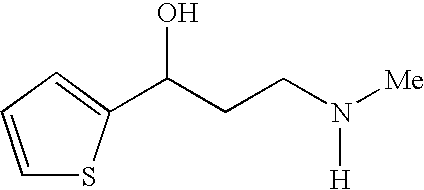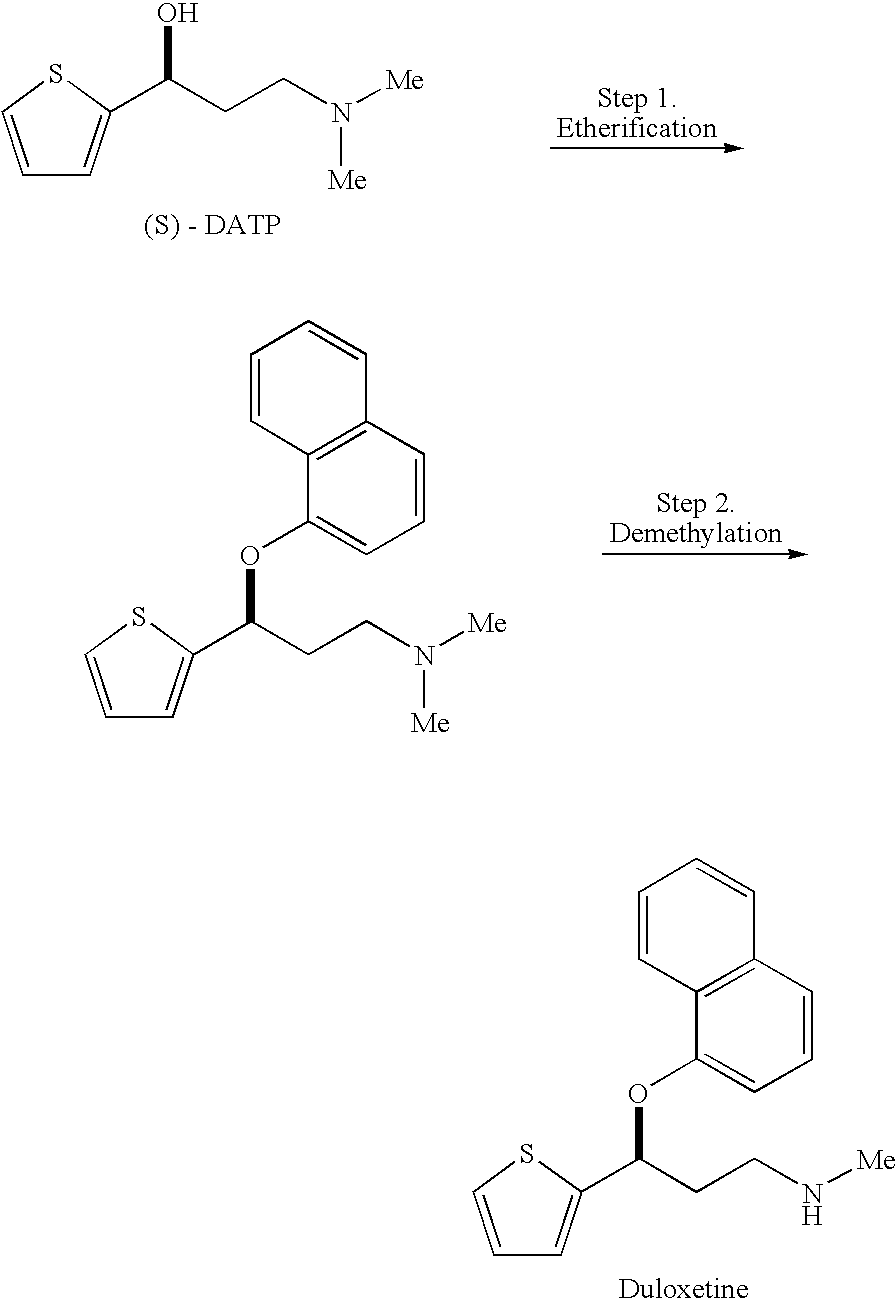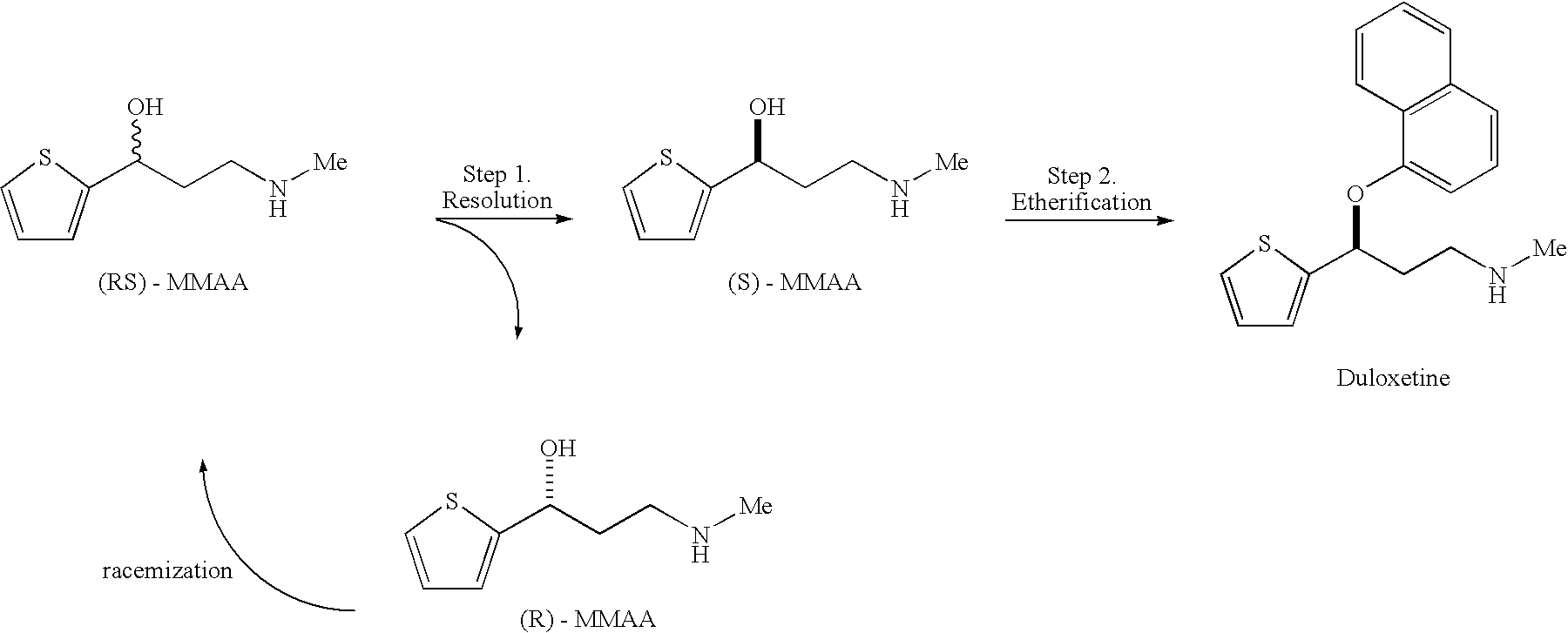Process for preparing optically active 3-(methylamino)-1-(2-thienyl) propan-1-ol and intermediates for preparation
a technology of methylamino and propan, which is applied in the field of process for preparing optically active 3(methylamino)1(2thienyl) propan1ol, can solve the problems of low yield, low yield, and low yield of synthesis, and achieves high optical purities and advantageous industrial applications.
- Summary
- Abstract
- Description
- Claims
- Application Information
AI Technical Summary
Benefits of technology
Problems solved by technology
Method used
Image
Examples
example 1
Preparation of (S)-MMAA.(S)-Mandlic Acid Monohydrate (Optical Resolution of MMAA using Optically Active Mandelic Acid)
[0035] (RS)-MMAA 100 g (0.584 mol) was charged to 2-butanol 190 g, and (S)-mandelic acid 89 g (0.584 mol) was added (molar ratio 1:1), and further, water 21 g (1.17 mol) was added thereto. The mixture was heated to dissolve the salts. Then, the resulting solution was cooled to 35° C., and a small amount of previously prepared seed crystals of (S)-MMAA.(S)-mandlic acid monohydrate was added to the solution and cooled to 20° C. The precipitated crystal was filtered and dried to give 83.2 g of (S)-MMAA.(S)-mandlic acid monohydrate. The yield of the salt based on the (RS)-MMAA was 83.4%, and the optical purity of the salt obtained was 75.2% de.
[0036] The crude salt was recrystallized from a mixed solvent of water and 2-butanol. Recrystallized salt, (S)-MMAA.(S)-mandelic acid monohydrate was 66.1 g and the optical purity thereof was 95.3% de. The yield of the salt based...
example 2
Preparation of (S)-MMAA
[0042] After addition of water to the diastereomeric salt prepared in Example 1, 30% sodium hydroxide aqueous solution was added and the mixture was shaken with 2-butanol. The resulting organic layer was separated and concentrated under reduce pressure. The concentrate thus obtained was added to toluene and dissolved by heating, then gradually cooled to 45° C. A small amount of seed crystal of (S)-MMAA previously prepared was added and the solution was cooled to ambient temperature. The precipitated crystals were filtered and dried. (S)-MMAA of 43.8 g was obtained. The yield based on the crude salt was 66% and the optical purity was 99.9% ee.
[0043] m.p.: 70.5-73.0° C.
[0044] Rotation: [α]D20−16.5° (c 1.0, EtOH)
[0045] IR (KBr), cm−1: 3384, 3284, 1489, 1303, 1178, 1110, 1085, 709
[0046]1H-NMR (d6-DMSO, 400 MHz): δ 7.20(d, J=5.2 Hz, 1H), 6.96(dd, J=3.2, 5.2 Hz, 1H), 6.92(d, J=3.2 Hz, 1H), 5.17(dd, J=3.2, 8.0 Hz, 1H), 2.94(ddd, J=3.6, 5.6, 8.0 Hz, 1H), 2.84(ddd...
example 3
Optical Resolution of MMAA with Optically Active α-Methoxyphenylacetic Acid
[0047] To the (RS)-MMAA 1.00 g (5.84 mmol) was added to 2-propanol 5 g and (R)-α-methoxyphenylacetic acid 0.96 g (5.84 mmol, molar ratio 1:1). After addition of water 0.1 g, the mixture was heated to dissolve the solids. The resulting solution was gradually cooled to 25° C., and a small amount of previously prepared (S)-MMAA.(R)-α-methoxyphenylacetic acid was added as the seed crystals. The solution was cooled to 20° C. The precipitated crystals were filtered and dried. Crude (S)-MMAA.(R)-α-methoxyphenylacetic acid was 0.51 g. The yield based on the (S)-MMAA in the (RS)-MMAA was 52%, and the optical purity of the salt was 73.3% de. The salt was recrystallized from 2-propanol to give pure (S)-MMAA.(R)-α-methoxyphenylacetic acid. The optical purity of the MMAA in the pure salt was 100% de.
[0048] m.p.: 106.0-106.8° C.
[0049] Rotation: [α]D20−61.3° (c 1.0, EtOH)
[0050] IR (KBr) cm−1: 3316 3062, 2876, 1620, 1567...
PUM
 Login to View More
Login to View More Abstract
Description
Claims
Application Information
 Login to View More
Login to View More - R&D
- Intellectual Property
- Life Sciences
- Materials
- Tech Scout
- Unparalleled Data Quality
- Higher Quality Content
- 60% Fewer Hallucinations
Browse by: Latest US Patents, China's latest patents, Technical Efficacy Thesaurus, Application Domain, Technology Topic, Popular Technical Reports.
© 2025 PatSnap. All rights reserved.Legal|Privacy policy|Modern Slavery Act Transparency Statement|Sitemap|About US| Contact US: help@patsnap.com



